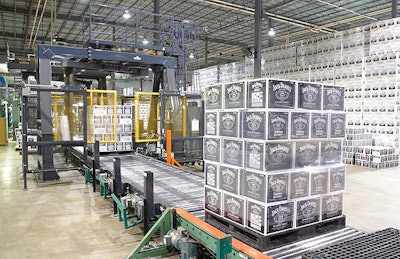
Its signature square glass bottle with a fluted neck, black body label and neckband lend Jack Daniel’s whiskey the distinctive shelf appeal that maintains the company’s origins and traditions. Jack Daniel’s Lynchburg, TN, distillery maintains exacting standards throughout bottling and packaging to protect the bottled liquor. Critical to this process is stretch-wrapping machinery from Orion Packaging Systems.
At the fill-to-order facility, whiskey is made using the distillery’s recipe created in 1866. A charcoal mellowing process followed by aging in American White Oak barrels gives the whiskey its smoky flavor and amber tint.
In the early 1990s, Jack Daniel’s product engineer Bill Mace decided it was time to automate the company’s stretch-wrapping line. “It is essential that our products always arrive in pristine condition, including overseas shipments. As our international business grew, the product was introduced to rail and water—we had to find a way to maintain and guarantee the quality while in transit. Automated stretch wrapping provides the same level of quality assurance and protection for each unitized pallet load that our proprietary packaging does on the inside of the case.”
At that time, the distillery purchased its first Orion MA-33 fully automatic stretch wrapper that operated at speeds to 60 pallets/hr. Mace says, “our customers had come to expect a sturdy wrap, so their product always arrived without damage.”
Rotary unit is selected
When the plant sought to add another wrapper more recently, several vendors were willing to create a customized machine, but Mace was more interested in a standard machine. “We wanted a rotary wrapper that allowed the product to remain stable while it was wrapped, as opposed to turning [the load] on a turntable. Orion was the only company that had a piece of equipment that could accommodate our needs.
“Also,” Mace continues, “Orion had just installed two new MA-33s at a manufacturer down the road from [our] plant, and a group of us went to look at them running. That company’s project engineers told us that the Orion wrapper had been one of the best projects [on which] they ever worked. It confirmed what we already knew from our own Orion experience.”
The new MA-33 ultra-high-speed stretch wrapper delivers a maximum wrapping capacity of 92 loads/hr. To reach that rate, the machine features a three-speed configuration and direct braking system.
According to Paul Maxwell, the distillery’s distribution manager, “we are running at about 80 loads per hour, two shifts a day, 99 percent of the time.” The older equipment now runs only as a backup, he says.
Meanwhile, the newer MA-33 employs a film delivery system that was upgraded to load 30”-wide film webs instead of the standard 20”, and includes a wider film tail wipe-down device for sealing the wider film. The film clamp was raised to provide a bottom edge of film 6” above the conveyor so that the film does not overwrap the pallet in the load. That way, workers at the facility can use a clamp truck to pick up the load without the pallet. By shipping cubed loads, fewer pallets are used, which ultimately leads to cost savings.
Other benefits of the MA-33 include Orion’s RevoLogic™ feature that counts each wrap of prestretched film to help eliminate waste and ensure an exact number of top-and-bottom wraps. Orion’s Insta-Sense™ technology pauses the wrap cycle if the stretch film breaks or runs out; once cleared, it continues wrapping from the same spot to complete the cycle.
‘Wrapping’ up
The wrapper accepts pallets from seven packaging lines at Lynchburg. The lines produce different bottle sizes, weights, and shapes, ranging from miniatures to 1.75 L. Before reaching the stretch wrapper, bottles are filled, capped, labeled, sealed, case packed, and palletized. Pallets are conveyed onto Orion’s infeed conveyor. An electronic photoeye detects pallet loads waiting to enter into the wrap zone. As each pallet enters the wrapping area, a photoeye signals safety gates to close.
Next, the wrap cycle begins and Orion’s Insta-Thread™ film carriage applies film that has been prestretched 217%, says Maxwell. The company uses low-density polyethylene film, though it prefers not to divulge the name of the local supplier. Maxwell does say that the facility has downgauged to 80-ga stretch film. He notes that the machine is used for pallet loads up to 2겨 lb and 54” high, though the wrapper is rated for both heavier and taller loads.
The arm rotates around the load as the film carriage cycles up to the top of the load and then back down for 10 to 12 revolutions, depending on load height, before finishing at the base of the load. At the end of the cycle, the film tail is automatically cut and secured to the base of the load. Following the wrapping sequence, the safety gates open and the load moves onto one of four outfeed conveyors. If clear, the load will sequence to the end of the conveyor line where it will be picked up by a forklift. The machine requires only one operator, who runs both the clamp forklift and the wrapper.
“Our stretch wrappers assure us that loads are wrapped as securely upon arrival as they are when they left our plant,” says Mace. “We knew we could rely on Orion to protect our package-product integrity.” —JB






















